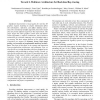Free Online Productivity Tools
i2Speak
i2Symbol
i2OCR
iTex2Img
iWeb2Print
iWeb2Shot
i2Type
iPdf2Split
iPdf2Merge
i2Bopomofo
i2Arabic
i2Style
i2Image
i2PDF
iLatex2Rtf
Sci2ools
MICRO
2008
IEEE
2008
IEEE
Toward a multicore architecture for real-time ray-tracing
Significant improvement to visual quality for real-time 3D graphics requires modeling of complex illumination effects like soft-shadows, reflections, and diffuse lighting interactions. The conventional Z-buffer algorithm driven GPU model does not provide sufficient support for this improvement. This paper targets the entire graphics system stack and demonstrates algorithms, a software architecture, and a hardware architecture for real-time rendering with a paradigm shift to ray-tracing. The three unique features of our system called Copernicus are support for dynamic scenes, high image quality, and execution on programmable multicore architectures. The focus of this paper is the synergy and interaction between applications, architecture, and evaluation. First, we describe the ray-tracing algorithms which are designed to use redundancy and partitioning to achieve locality. Second, we describe the architecture which uses ISA specialization, multithreading to hide memory delays and su...
| Added | 31 May 2010 |
| Updated | 31 May 2010 |
| Type | Conference |
| Year | 2008 |
| Where | MICRO |
| Authors | Venkatraman Govindaraju, Peter Djeu, Karthikeyan Sankaralingam, Mary Vernon, William R. Mark |
Comments (0)

